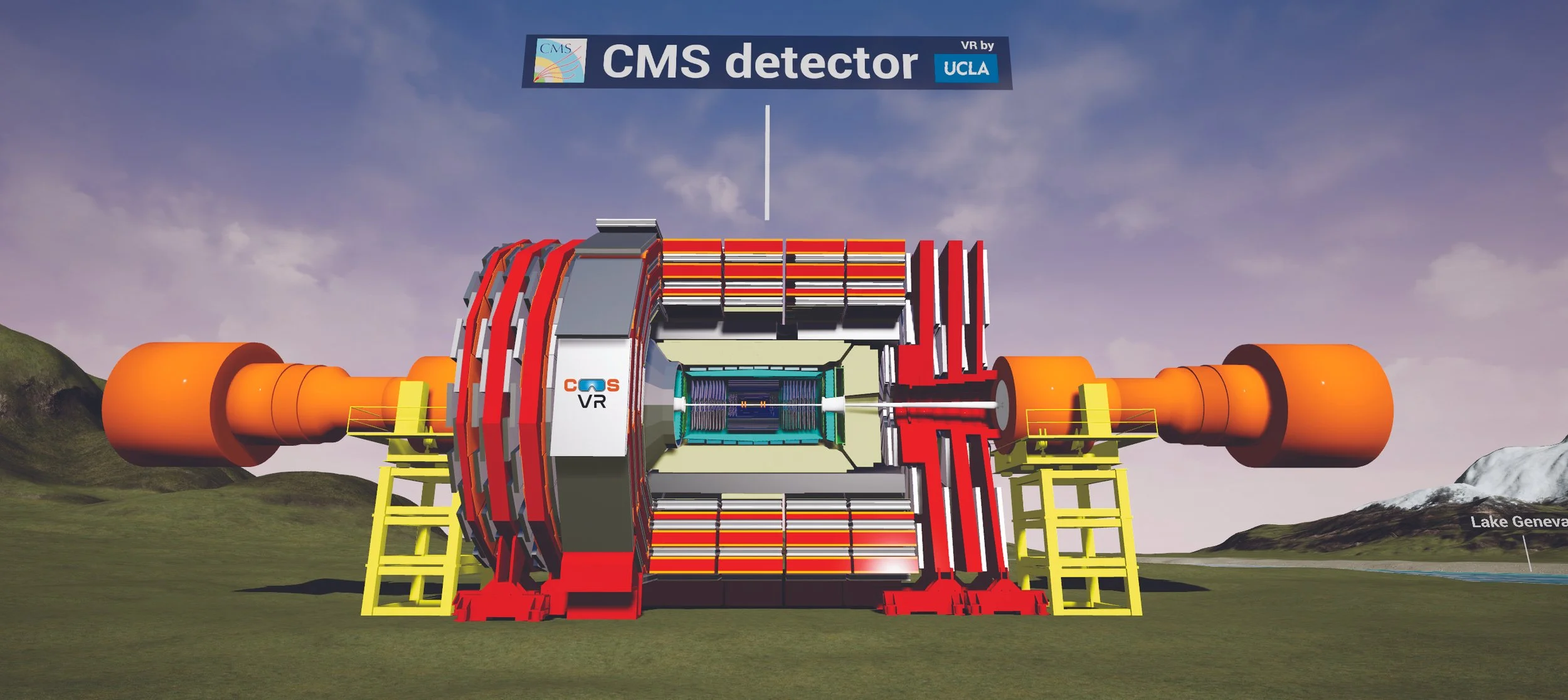Virtual Reality and Hunting for New Physics at the Energy Frontier
The UCLA VR detector display shows many detector components.
Professors Bachtis, Cousins, Hauser, Saltzberg
We focus on two topics: the application of Virtual Reality (VR) to particle physics and recent searches by the group for new physics at the energy frontier of the Large Hadron Collider (LHC).
Virtual Reality
High-energy beams of the LHC meet 40 million times per second in the Compact Muon Solenoid (CMS) detector. Each time they meet, protons from one beam interact with protons in another, creating charged and neutral particles that stream outward from the collision.
While CMS scientists have visualized LHC collisions on two-dimensional screens for decades, in summer 2022 Prof. Jay Hauser, postdoc Ansar Iqbal and undergraduates Ethan Hsu, Joseph Malham, and Amy Hu began creating the first VR displays that allow viewers to step inside the events. These VR displays not only give “360” views in all directions, but allow observers to change their vantage points and see otherwise hidden details of the collisions. Remarkably, this is the first application of VR to particle physics interactions.
VR displays can:
● be educational, as popular exhibits at the latest Exploring Your Universe public event and for virtual tours of CMS (Fig 1);
● show the new, massively upgraded elements of the CMS detector to acquaint scientists and engineers with its layout (Fig. 2);
● reveal complex aspects of the collision data, such as the intersections of particle trajectories, and take advantage of its capabilities to not only see data in 3D, but also to move within the data using handsets (Fig 3).
At present, it is not easy to develop the software, and headsets are only usable by one person at a time and they are not high-performance or comfortable. However, we have overcome the basic software hurdles and are continuing to improve VR as a powerful visualization technology for particle physics.
Searching for New Physics:
A complete CMS data analysis is a giant edifice that takes years to construct. Below is a summary of our group's recent attempts to find new particles and forces:
• Searches for Z-prime particles: Professor Robert Cousins, research associate Slava Valuev, and graduate students Riju Dasgupta and Chris Schnaible looked for extremely massive versions of the photon and Z bosons predicted by many theories that unify the forces of nature. (Published)
• Searches for Black Holes and Sphalerons: Professor Jay Hauser and graduate students Cameron Bravo and Ya-Feng (Celia) Lo looked for especially explosive events that would signal the production of a microscopic black hole or the tunneling to a new vacuum of spacetime, known as a sphaleron. (Published and in progress)
• Multiple searches for new TeV bosons, X: Professors David Saltzberg and Michalis Bachtis with postdocs Nickolas McColl, Simon Regnard, and graduate students Brent Stone and David Hamilton conducted searches for a new boson, called X, with mass well over a trillion electron volts. These X particles could be variants of the Higgs boson we know or signal excitations in extra spacetime dimensions. (Published)
• Measuring the W boson mass Professor Michalis Bachtis, postdoc Elisabetta Manca and graduate student Gael Flores Avila are working to resolve a world-wide disagreement among measurements of the well-predicted mass of the W boson, carrier of the weak force. Their measurement accuracy will be better than 0.02%. (In progress)
• Multiple searches for long-lived particles: Theorists are keen to predict new particles with anomalously long lifetimes. Professors Jay Hauser, Robert Cousins, Michalis Bachtis, postdoc Ansar Iqbal, and graduate students Will Nashand Tyler Lam are searching in a variety of ways, with decays to muons (see Fig. 4) or photons. (Published and in progress)
• Measuring the coupling of the Higgs boson to top quarks: Postdoc Abhisek Datta measured this key coupling between the two heaviest elementary particles. (Published)
• Measuring the Higgs boson self-coupling: One of the main goals of the LHC is to observe the Higgs boson coupling to itself. Professor David Saltzberg, postdoc Abhisek Datta, and graduate students Antonett Prado and Sam Crossley have begun improving this measurement. (In progress)




